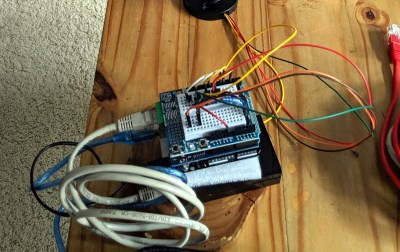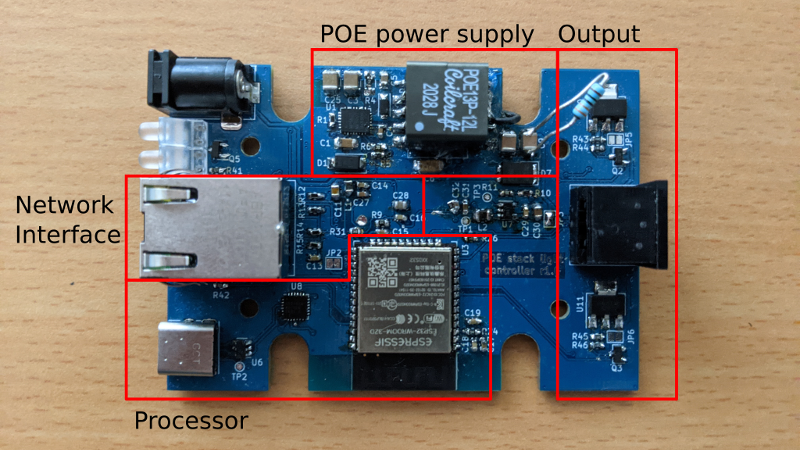A common sight on factory floors, stack lights are used to indicate the status of machinery to anyone within visual range. But hackers have found out you can pick them up fairly cheap online, so we’ve started to see them used as indicators in slightly more mundane situations than they were originally intended for. [Tyler Ward] recently decided he wanted his build own network controlled stack light, and thought it would double as a great opportunity to dive into the world of Power Over Ethernet (PoE).
Now the easy way to do this would be to take the Raspberry Pi, attach the official PoE Hat to it, and toss it into a nice enclosure. Write some code that toggles the GPIO pins attached to the LEDs in the stack light, and call it a day. Would be done in an afternoon and you could be showing it off on Reddit by dinner time. But that’s not exactly what [Tyler] had in mind.

He decided to take the scenic route and designed his own custom PCB that combines an Ethernet interface, PoE hardware, and the ESP32 into one compact unit. It’s no great secret that it only takes a few extra components to plug the ESP32 into the network rather than relying on WiFi, but it’s still not something we see done very often by hobbyists. Rarer still is seeing somebody roll their own PoE solution, but thanks to the in-depth documentation [Tyler] has provided for his circuit, that may change in the future.
On the software side [Tyler] has developed a firmware for the ESP32 that supports both Art-Net and RDM protocols, which are subsets of the larger DMX protocol. That means the controller should be compatible with existing software designed for controlling theatrical lighting systems. If you’d rather take a more direct approach, the firmware also sports a web interface and simple HTTP API to provide some additional flexibility.
While it’s exceptionally impressive, not everyone will need such a robust solution. If you just want a quick and easy way to fire up your stack light, a USB controlled relay and some Python can get you where you need to go.
















Fairly cheap! That’s tens of dollars, at least!
If you’ve got a 3D printer and a parts bin of LEDs there’s a model up on Thingiverse to DIY the whole build. https://www.thingiverse.com/thing:4268994
A cool project writeup is nice, doubly so for a .io project, but would really appreciate a photo that includes a “stack light” itself – had to visit the project page to see what’s that about =)
Wait… all of that tech to power a single stack light? That’s quite some overengineering, I’d say, even culturally insensitive because of the whole “silicon shortage” thing going on ;-P At least add some more connector footprints to wire up additional stack lights, since they’re so cheap and all =)
“culturally insensitive”
huh?
I’m really not seeing that. Dude used a single micro, and a few chips. The shortage isn’t anywhere close to severe enough that building a single product will have any effect on it at all.
Sometimes overengeneering is fun. I don’t see where he claimed that this was the most simple way of doing it. Moreover, he documented how to build an esp32 + poe circuit, so I see this as a win!
Try being less negitive.
It’s easy to snark and think “Gee, an ethernet cable has 8 wires – I could just run that light without that mess of electronics in the middle.”
But that’s kind of missing the point. The point is not to have a stack light. The point is to have a working hardware and software stack for applications like this, and document how to do it. To that end, this project worked well. I’m thinking about borrowing some of those ideas for my own DMX project.
Finally someone who Gets it; the stack light is mainly an example use case here
What do you mean by “The point is not to have a stack light.”? I just got a job at a manufacturing facility. We have stack lights all over the place. I’m not sure what you mean by the statement so I’m curious. Thanks!
Read the article, or the page it links to. The point of the exercise was not to necessarily end up with a stack light (because, honestly, this is a silly way to implement it). The objective was to use the stack light as a simple, definable goal to direct the development of the hardware and software techniques using that enable it (and future projects).
As an equipment engineer I second your sentiment. An affordable POE based stack light could reduce wiring complexity and part count (same cables as POE cameras, IO modules, etc and eliminate an IO module for a simple stack light). Ethernet based control systems have long been trending in our industry as the direction of the future for their modularity and ease of use but price has held them back from many use cases.